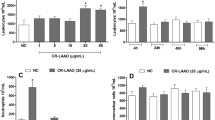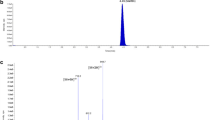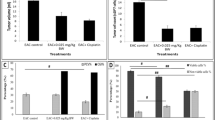Abstract
Extraction and characterization of natural products provide the opportunity to expand our arsenal of drug candidates against a wide range of diseases including cancer and inflammatory disorders. Previous studies have shown bee venom to have immense potential as an anti-inflammatory drug candidate. In this study, we focused on the venom of Apis mellifera anatoliaca and characterized its content by HPLC. An in vitro inflammation model based on lipopolysaccharide (LPS)-stimulated mammalian macrophages was utilized to examine the venom’s anti-inflammatory potential. Additionally, its antiproliferative activity was evaluated in vitro against a human glioblastoma cell line. Based on the TNF, IL6, GMCSF, and IL12p40 pro-inflammatory cytokine production level in LPS-induced macrophages, venom-treated groups showed substantial decrease in the inflammatory action compared to untreated LPS-stimulated macrophages. When the cells were analyzed for viability, the venom did not have any cytotoxic effect on the macrophages at the concentration ranges that were utilized. Moreover, IC50 value of the venom was above 60 µg/mL on glioblastoma cancer cell line. These results suggest that the Apis mellifera anatoliaca venom does not have anticancer drug candidate potential, whereas it can efficiently be used against inflammatory and autoimmune disorders. To our knowledge, this is the first study to specifically examine the effect of anti-inflammatory activity of Apis mellifera anatoliaca venom on macrophages.
Graphical Abstract








Similar content being viewed by others
Data Availability
This article has no additional data.
References
Abd El-Wahed, A. A., Khalifa, S. A., Sheikh, B. Y., Farag, M. A., Saeed, A., Larik, F. A., ... & El-Seedi, H. R. (2019). Bee venom composition: From chemistry to biological activity. In Studies in Natural Products Chemistry, 60, 459–484. Elsevier.
Ayaz, F., Alas, M. O., & Genc, R. (2020). Differential immunomodulatory effect of carbon dots influenced by the type of surface passivation agent. Inflammation, 43, 777–783. https://doi.org/10.1007/s10753-019-01165-0
Bellik, Y. (2015). Bee venom: Its potential use in alternative medicine. Anti-infective Agents, 13(1), 3–16.
Bilir, E. K., Tutun, H., Sevin, S., Kismali, G., & Yarsan, E. (2018). Cytotoxic effects of Rhododendron ponticum L. extract on prostate carcinoma and adenocarcinoma cell line (DU145, PC3). KafkasÜniversitesiVeterinerFakültesiDergisi, 24(3).
Borojeni, S. K., Zolfagharian, H., Babaie, M., & Javadi, I. (2020). Cytotoxic effect of bee (A mellifera) venom on cancer cell lines. Journal of Pharmacopuncture, 23(4), 212.
Chen, J., & Lariviere, W. R. (2010). The nociceptive and anti-nociceptive effects of bee venom injection and therapy: A double-edged sword. Progress in Neurobiology, 92(2), 151–183.
Danneels, E. L., Van Vaerenbergh, M., Debyser, G., Devreese, B., & de Graaf, D. C. (2015). Honeybee venom proteome profile of queens and winter bees as determined by a mass spectrometric approach. Toxins, 7(11), 4468–4483.
El-Seedi, H., El-Wahed, A., Yosri, N., Musharraf, S. G., Chen, L., Moustafa, M., ... & Khalifa, S. (2020). Antimicrobial properties of apismellifera’s bee venom. Toxins, 12(7), 451.
Foey, A. D., & Brennan, F. M. (2004). Conventional protein kinase C and atypical protein kinase Czeta differentially regulate macrophage production of tumour necrosis factor-alpha and interleukin-10. Immunology, 112(1), 44–53. https://doi.org/10.1111/j.1365-2567.2004.01852.x]
Frangieh, J., Salma, Y., Haddad, K., Mattei, C., Legros, C., Fajloun, Z., & El Obeid, D. (2019). First characterization of the venom from Apismelliferasyriaca, a honeybee from the Middle East region. Toxins, 11, 191. https://doi.org/10.3390/toxins11040191
Fujiwara, N., & Kobayashi, K. (2005). Macrophages in inflammation. Current Drug Targets: Inflammation & Allergy, 4(3), 281–286. https://doi.org/10.2174/1568010054022024
Furkan, A. Y. A. Z. (2018). Ruthenium based photosensitizer exerts immunostimulatory and possible adjuvant role on the mammalian macrophages in vitro. Cumhuriyet Science Journal, 39(4), 991–998.
Gallego, C., Golenbock, D., Gomez, M. A., & Saravia, N. G. (2011). Toll-like receptors participate in macrophage activation and intracellular control of Leishmania (Viannia) panamensis. Infection and Immunity, 79(7), 2871–2879. https://doi.org/10.1128/IAI.01388-10
Gordon, S., & Martinez-Pomares, L. (2017). Physiological roles of macrophages. PflugersArchiv : European Journal of Physiology, 469(3–4), 365–374. https://doi.org/10.1007/s00424-017-1945-7
Ma, W. T., Gao, F., Gu, K., & Chen, D. K. (2019). The Role of Monocytes and Macrophages in Autoimmune Diseases: A Comprehensive Review. Frontiers in Immunology, 10, 1140. https://doi.org/10.3389/fimmu.2019.01140]
Grip, O., Janciauskiene, S., & Lindgren, S. (2003). Macrophages in inflammatory bowel disease. Current Drug Targets: Inflammation & Allergy, 2(2), 155–160. https://doi.org/10.2174/1568010033484179
Hong, S. J., Rim, G. S., Yang, H. I., Yin, C. S., Koh, H. G., Jang, M. H., ... & Chung, J. H. (2005). Bee venom induces apoptosis through caspase-3 activation in synovial fibroblasts of patients with rheumatoid arthritis. Toxicon, 46(1), 39-45.
Jang, M. H., Shin, M. C., Lim, S., Han, S. M., Park, H. J., Shin, I., ... & Kim, C. J. (2003). Bee venom induces apoptosis and inhibits expression of cyclooxygenase-2 mRNA in human lung cancer cell line NCI-H1299. Journal of Pharmacological Sciences, 91(2), 95-104.
Jurna, I. (1997). Response to Lariviere and Melzack, PAIN, 66 (1996) 271–277: PAIN 3293. Pain, 71(1), 113–114.
Kany, S., Vollrath, J. T., & Relja, B. (2019). Cytokines in inflammatory disease. International Journal of Molecular Sciences, 20(23), 6008. https://doi.org/10.3390/ijms20236008
Karimi, A., Ahmadi, F., Parivar, K., Nabiuni, M., Haghighi, S., Imani, S., & Afrouzi, H. (2012). Effect of honey bee venom on lewis rats with experimental allergic encephalomyelitis, a model for multiple sclerosis. Iranian Journal of Pharmaceutical Research: IJPR, 11(2), 671.
Kim, H. W., Kwon, Y. B., Ham, T. W., Roh, D. H., Yoon, S. Y., Lee, H. J., ... & Lee, J. H. (2003). Acupoint stimulation using bee venom attenuates formalin-induced pain behavior and spinal cord fos expression in rats. Journal of Veterinary Medical Science, 65(3), 349-355.
Kokot, Z. J., & Matysiak, J. (2009). Simultaneous determination of major constituents of honeybee venom by LCDAD. Chromatographia, 69(11–12), 1401–1405.
Kwon, Y. B., Lee, J. D., Lee, H. J., Han, H. J., Mar, W. C., Kang, S. K., ... & Lee, J. H. (2001). Bee venom injection into an acupuncture point reduces arthritis associated edema and nociceptive responses. Pain, 90(3), 271-280.
Lee, G., & Bae, H. (2016). Anti-inflammatory applications of melittin, a major component of bee venom: Detailed mechanism of action and adverse effects. Molecules (Basel, Switzerland), 21(5), 616. https://doi.org/10.3390/molecules21050616]
Leuschner, C., & Hansel, W. (2004). Membrane disrupting lytic peptides for cancer treatments. Current Pharmaceutical Design, 10(19), 2299–2310.
Ling, C. Q., Li, B., Zhang, C., Gu, W., Li, S. X., Huang, X. Q., & Zhang, Y. N. (2004). Anti-hepatocarcinoma effect of recombinant adenovirus carrying melittin gene. Zhonghuaganzangbingzazhi= Zhonghuaganzangbingzazhi= Chinese journal of hepatology, 12(12), 741–744.
Liu, X., Chen, D., Xie, L., & Zhang, R. (2002). Effect of honey bee venom on proliferation of K1735M2 mouse melanoma cells in-vitro and growth of murine B16 melanomas in-vivo. Journal of Pharmacy and Pharmacology, 54(8), 1083–1089.
Lue, H., Dewor, M., Leng, L., Bucala, R., & Bernhagen, J. (2011). Activation of the JNK signalling pathway by macrophage migration inhibitory factor (MIF) and dependence on CXCR4 and CD74. Cellular Signalling, 23(1), 135–144. https://doi.org/10.1016/j.cellsig.2010.08.013
Moon, D. O., Park, S. Y., Heo, M. S., Kim, K. C., Park, C., Ko, W. S., ... & Kim, G. Y. (2006). Key regulators in bee venom-induced apoptosis are Bcl-2 and caspase-3 in human leukemic U937 cells through downregulation of ERK and Akt. International Immunopharmacology, 6(12), 1796-1807.
Moreno, M., & Giralt, E. (2015). Three valuable peptides from bee and wasp venoms for therapeutic and biotechnological use: Melittin, apamin and mastoparan. Toxins, 7(4), 1126–1150.
Nam, K. W., Je, K. H., Lee, J. H., Han, H. J., Lee, H. J., Kang, S. K., & Mar, W. (2003). Inhibition of COX-2 activity and proinflammatory cytokines (TNF-alpha and IL-1beta) production by water-soluble sub-fractionated parts from bee (Apis mellifera) venom. Archives of Pharmacal Research, 26(5), 383–388.
Oršolić, N. (2012). Bee venom in cancer therapy. Cancer and metastasis reviews, 31(1), 173–194.
Ovcharov, R., Shkenderov, S., & Mihailova, S. (1976). Anti-inflammatory effects of apamin. Toxicon, 14(6), 441–447. https://doi.org/10.1016/0041-0101(76)90060-x. PMID: 1014033.
Pacakova, V., Štulík, K., Hau, P. T., Jelinek, I., Vinš, I., & Sýkora, D. (1995). Comparison of high-performance liquid chromatography and capillary electrophoresis for the determination of some bee venom components. Journal of Chromatography A, 700(1), 187–193.
Premratanachai, P., & Chanchao, C. (2014). Review of the anticancer activities of bee products. Asian Pacific Journal of Tropical Biomedicine, 4(5), 337–344.
Pucca, M. B., Cerni, F. A., Oliveira, I. S., Jenkins, T. P., Argemí, L., Sørensen, C. V., ... & Laustsen, A. H. (2019). Bee updated: Current knowledge on bee venom and bee envenoming therapy. Frontiers in Immunology, 10, 2090.
Rybak-Chmielewska, H., & Szczêsna, T. (2004). HPLC study of chemical composition of honeybee (Apis mellifera L.) venom. Journal of Apicultural Science, 48(2), 103–109.
Sharif, O., Brunner, J. S., Vogel, A., & Schabbauer, G. (2019). Macrophage rewiring by nutrient associated PI3K dependent pathways. Frontiers in Immunology, 10, 2002. https://doi.org/10.3389/fimmu.2019.02002
Şirin, Y., Çalı, H. E., Can, Z., Yıldız, O., & Kolayli, S. (2017). Bal ArisiZehrininKarakterizasyonundaSds-Page ElektroforezKullanilabilirliğininAraştirilmasi. UludağArıcılıkDergisi, 16(2), 49–56.
Sisakht, M., Mashkani, B., Bazi, A., Ostadi, H., Zare, M., Avval, F. Z., ... & Soukhtanloo, M. (2017). Bee venom induces apoptosis and suppresses matrix metaloprotease-2 expression in human glioblastoma cells. RevistaBrasileira de Farmacognosia, 27, 324-328.
Son, D. J., Lee, J. W., Lee, Y. H., Song, H. S., Lee, C. K., & Hong, J. T. (2007). Therapeutic application of anti-arthritis, pain-releasing, and anti-cancer effects of bee venom and its constituent compounds. Pharmacology & Therapeutics, 115(2), 246–270.
Taylor, W. F., & Jabbarzadeh, E. (2017). The use of natural products to target cancer stem cells. American Journal of Cancer Research, 7(7), 1588.
Tekeoğlu, İ, Akdoğan, M., & Çelik, İ. (2020). Investigation of anti-inflammatory effects of bee venom in experimentally induced adjuvant arthritis. Reumatologia, 58(5), 265–271. https://doi.org/10.5114/reum.2020.99764
Tutun, S., Kaya, M. M., Usluer, M. S., & Tutun, H. (2020). Investigation of antiproliferative effects of Hypericum perforatum oil on myeloma cells. Veterinary Journal of Mehmet AkifErsoy University, 5(2), 79–82.
Udalova, I., Mantovani, A., & Feldmann, M. (2016). Macrophage heterogeneity in the context of rheumatoid arthritis. Nature Reviews Rheumatology, 12, 472–485. https://doi.org/10.1038/nrrheum.2016.91
Varanda, E. A., Monti, R., & Tavares, D. C. (1999). Inhibitory effect of propolis and bee venom on the mutagenicity of some direct- and indirect-acting mutagens. Teratogenesis Carcinogenesis and Mutagenesis, 19(6), 403–413.
Varbanov, H. P., Kuttler, F., Banfi, D., Turcatti, G., & Dyson, P. J. (2017). Repositioning approved drugs for the treatment of problematic cancers using a screening approach. PLoS One, 12(2), e0171052.
Vogel, D. Y., Vereyken, E. J., Glim, J. E., Heijnen, P. D., Moeton, M., van der Valk, P., Amor, S., Teunissen, C. E., van Horssen, J., & Dijkstra, C. D. (2013). Macrophages in inflammatory multiple sclerosis lesions have an intermediate activation status. Journal of Neuroinflammation, 10, 35. https://doi.org/10.1186/1742-2094-10-35
Wynn, T. A., Chawla, A., & Pollard, J. W. (2013). Macrophage biology in development, homeostasis and disease. Nature, 496(7446), 445–455. https://doi.org/10.1038/nature12034
Zhang, J. M., & An, J. (2007). Cytokines, inflammation, and pain. International Anesthesiology Clinics, 45(2), 27–37. https://doi.org/10.1097/AIA.0b013e318034194e]
Zhang, Z., Zhan, W., Chen, H., Chen, Y., Li, C., Yang, Y., ... & Sharma, A. (2020). Inhibitory effect of SiweiXiaoliuyin on glioma angiogenesis in nude mice. International Review of Neurobiology, 151, 243-252.
Author information
Authors and Affiliations
Contributions
All authors contributed to the study conception and design. S.S. and H.T. provided bee venom. R.U., S.S., and H.T performed cell viability test. I.K. performed component analysis. Biological analysis and data collection were performed by F.A. The first draft of the manuscript was written by F.A, and HT helped shape the manuscript with support from RU and FA. All authors commented on previous versions of the manuscript. All authors read and approved the final manuscript.
Corresponding author
Ethics declarations
Ethical Approval
Not applicable.
Consent to Participate
Not applicable.
Consent to Publish
All authors approved the last version of the manuscript before submission. We did not have any patient data or ethical condition therefore we did not need consent for that.
Competing Interests
The authors declare no competing interests.
Additional information
Publisher's Note
Springer Nature remains neutral with regard to jurisdictional claims in published maps and institutional affiliations.
Rights and permissions
Springer Nature or its licensor (e.g. a society or other partner) holds exclusive rights to this article under a publishing agreement with the author(s) or other rightsholder(s); author self-archiving of the accepted manuscript version of this article is solely governed by the terms of such publishing agreement and applicable law.
About this article
Cite this article
Sevin, S., Kivrak, İ., Tutun, H. et al. Apis mellifera anatoliaca Venom Exerted Anti-Inflammatory Activity on LPS-Stimulated Mammalian Macrophages by Reducing the Production of the Inflammatory Cytokines. Appl Biochem Biotechnol 195, 3194–3205 (2023). https://doi.org/10.1007/s12010-022-04284-x
Accepted:
Published:
Issue Date:
DOI: https://doi.org/10.1007/s12010-022-04284-x




